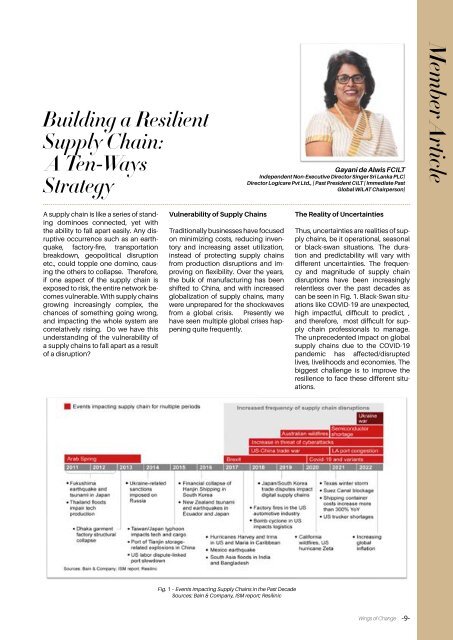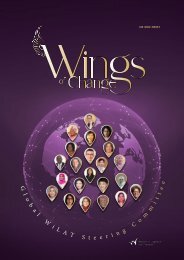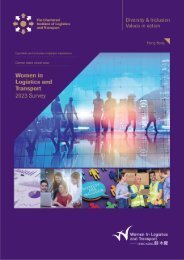Wings of Change Newsletter October 2023
The 9th edition of the newsletter from WiLAT
The 9th edition of the newsletter from WiLAT
You also want an ePaper? Increase the reach of your titles
YUMPU automatically turns print PDFs into web optimized ePapers that Google loves.
Building a Resilient<br />
Supply Chain:<br />
A Ten-Ways<br />
Strategy<br />
Gayani de Alwis FCILT<br />
Independent Non-Executive Director Singer Sri Lanka PLC|<br />
Director Logicare Pvt Ltd., | Past President CILT | Immediate Past<br />
Global WiLAT Chairperson|<br />
Member Article<br />
A supply chain is like a series <strong>of</strong> standing<br />
dominoes connected, yet with<br />
the ability to fall apart easily. Any disruptive<br />
occurrence such as an earthquake,<br />
factory-fire, transportation<br />
breakdown, geopolitical disruption<br />
etc., could topple one domino, causing<br />
the others to collapse. Therefore,<br />
if one aspect <strong>of</strong> the supply chain is<br />
exposed to risk, the entire network becomes<br />
vulnerable. With supply chains<br />
growing increasingly complex, the<br />
chances <strong>of</strong> something going wrong,<br />
and impacting the whole system are<br />
correlatively rising. Do we have this<br />
understanding <strong>of</strong> the vulnerability <strong>of</strong><br />
a supply chains to fall apart as a result<br />
<strong>of</strong> a disruption?<br />
Vulnerability <strong>of</strong> Supply Chains<br />
Traditionally businesses have focused<br />
on minimizing costs, reducing inventory<br />
and increasing asset utilization,<br />
instead <strong>of</strong> protecting supply chains<br />
from production disruptions and improving<br />
on flexibility. Over the years,<br />
the bulk <strong>of</strong> manufacturing has been<br />
shifted to China, and with increased<br />
globalization <strong>of</strong> supply chains, many<br />
were unprepared for the shockwaves<br />
from a global crisis. Presently we<br />
have seen multiple global crises happening<br />
quite frequently.<br />
The Reality <strong>of</strong> Uncertainties<br />
Thus, uncertainties are realities <strong>of</strong> supply<br />
chains, be it operational, seasonal<br />
or black-swan situations. The duration<br />
and predictability will vary with<br />
different uncertainties. The frequency<br />
and magnitude <strong>of</strong> supply chain<br />
disruptions have been increasingly<br />
relentless over the past decades as<br />
can be seen in Fig. 1. Black-Swan situations<br />
like COVID-19 are unexpected,<br />
high impactful, difficult to predict, ,<br />
and therefore, most difficult for supply<br />
chain pr<strong>of</strong>essionals to manage.<br />
The unprecedented impact on global<br />
supply chains due to the COVID-19<br />
pandemic has affected/disrupted<br />
lives, livelihoods and economies. The<br />
biggest challenge is to improve the<br />
resilience to face these different situations.<br />
Fig. 1 – Events Impacting Supply Chains in the Past Decade<br />
Sources: Bain & Company, ISM report; Resilinic<br />
<strong>Wings</strong> <strong>of</strong> <strong>Change</strong> -9-
















